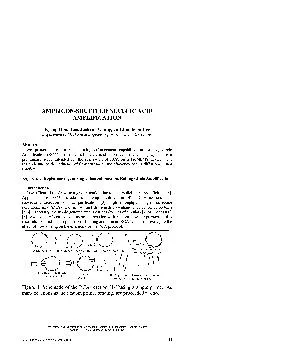/


KyongHoon Lee Jaehyun Chung and Junghoon Lee Department of Mechanical Engineering Northwestern Abstract We present a reactor with mixing enhancement capability for Rolling Circle Amplification ID: 168770
Download Pdf The PPT/PDF document "AMPLICO~-SHUTTLED NUCLEIC ACID AMPLIFICA..." is the property of its rightful owner. Permission is granted to download and print the materials on this web site for personal, non-commercial use only, and to display it on your personal computer provided you do not modify the materials and that you retain all copyright notices contained in the materials. By downloading content from our website, you accept the terms of this agreement.
AMPLICO~-SHUTTLED NUCLEIC ACID AMPLIFICATION Kyong-Hoon Lee, Jaehyun Chung, and Junghoon Lee Department of Mechanical Engineering, Northwestern Abstract We present a reactor with mixing enhancement capability for Rolling Circle Amplification (RCA), an isothermal nucleic acid amplification reaction [1,2]. This is a preliminary study intended for the realization of RCA on a bioMEMS device. This research studied the influence of flow stirring Keywords: droplet moving, mixing-enhanced reaction, Rolling Circle Amplification 1. Introduction RCA (Figure 1) is drawing a great attention due to its simplicity and specificity [l-8]. Applications of RCA include the on-chip amplification of a DNA sequence for subsequent “W . .._..__... .’ - Plasmid dsDNA Heat denaturization /..... . Random h-ma” primer binding CO~pltTle rand . ...__* RCA product Restriction digestion : concatemer for further use 7th lnternat~onal Conference on Miniaturized Chemical and Blochemlcal Analysts Systems October 5-9, 2003, Squaw Valley, Callfornla USA O-974361 I-0.O/~TAS2003/$15.0002003TRF 163 2. Theory In the RCA reaction (Figurel), the polymerization can be initiated where a hexamer primer binds rather nonspecifically with a template to create a substrate i, D; is its diffusion coefficient, r is the radius of the cylinder, VZ is the velocity of the flow along the z-axis. Our goal here is to manipulate V, and have the better reaction i. Figure 2. Pressure-driven mixing of ink- and water droplets. 3. Experimental We carried out two experiments. The first was to confirm that flow stirring (shuttling of a droplet) enhances the mixing efficiency, in comparison with a diffusion-controlled case. 7th lnternat~onal Conference on Miniaturized Chemical and Blochemlcal Analysts Systems October 5-9, 2003, Squaw Valley, Callfornla USA 164 were digested using an EcoRI restriction enzyme (New England Biolabs, Beverly, MA). The results were analyzed using gel electrophoresis and an imaging software. Biocompatible silicone tube Figure 3. Schematic of the RCA experiment. For the details, see the text 4. Results and Discussions The Figure 4. (a) Gel electrophoresis results (1% agarose gel, stained 2 (a)). Additionally it was also found that the shuttling gave a faster mixing than a unidirectional movement of the ink- and 7th lnternat~onal Conference on Miniaturized Chemical and Blochemlcal Analysts Systems October 5-9, 2003, Squaw Valley, Callfornla USA 165 As shown in Figure 4, the amplicon-shuttled reactions resulted in the single bands representing the desired product, while those with the simple incubation caused multiple bands with smears. It is considered that the enhanced-mixing by induced 5. Conclusions It was shown that the proposed mixing scheme for RCA could offer more reliable results in a time-efficient manner than the conventional diffusion-limited method. We are currently carrying out the microfabrication of the related bioMEMS device together with a theoretical analysis, based on the results presented here. Acknowledgement This work was supported References [I ] J. R. Nelson, Y. C. Cai, T.L. Giesler, J. W. Farchaus, S. T. Sundaram, M. Ortiz- Rivera, L. P. Biotechniques Suppl. S. JUN, 44 (2002) [2] B. Schweitzer, S. Kingsmore, Cm-. Opin. Biotechnol. 12,21 (2001) [3] G. Nallur, C. H. Luo, L. H. Fang, S. Cooley, V. Dave, J. Lambert, K. Kukanskis, S. Kingsmore, R. Lasken, B. Schweitzer, Nucleic Acids Rex 29, art. no. el18 (2001) [4] J. Pickering, Acids Res. 30, e 60 (2002) [5] B. Schweitzer, S. Roberts, B. Grimwade, W. P. Shao, M. J. Wang, Q. Fu, Q. P. Shu, I. Laroche, 2. M. Zhou, V. T. Tchernev, J. Christiansen, M. Velleca, S. F. Kingsmore, Nature Biotech. 20, 359, 252 (2002) [6] Curr. Opin. Biotechnol. 14, 74 (2003) [7] F. B. Dean, J. R. Nelson, T. L. Giesler, R. S. Lasken, Genome Res. 11, [8] F.B. Dean, S. Hosono, L.H. Fang, X.H. Wu, A.F. Faruqi, P. Bray-Ward, Z. Y. Sun, Q.L. Zong, Y. F. Du, J. Du, M. Driscoll, W.M. Song, S. F. Kingsmore, M. Egholm, R. S. Lasken, N&l. Acnd. Sci. USA. 99, 5261 (2002) [9] Y. Kohara, Anal. Chem. ASAP (2003) [lo] Q. Gan, S.J. Allen, G. Taylor, Biochem. Eng. J. 12,223 [ 1 l] L. Kvttinggen, B. Sjursnes, P. Halling, T. Anthonsen, Tetrahedron 48,5259 (I 992) 7th lnternat~onal Conference on Miniaturized Chemical and Blochemlcal Analysts Systems October 5-9, 2003, Squaw Valley, Callfornla USA 166